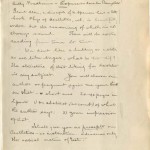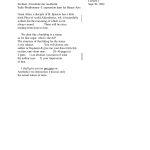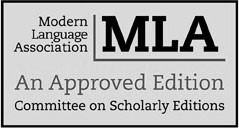Once the copy-text has been chosen it is transcribed into a Word or InDesign document including Santayana’s internal revisions added in brackets. To ensure the transcription (seen in figure 1) is correct, it is cross-checked by team collation against both the photocopies and the original manuscript. During the transcription process, the editors also make a list of possible compound words that were originally hyphenated at the ends of lines in the copy-text.
While the project editors are in the process of composing the critical text, they compile a list of the author’s revisions. If any of the changes show Santayana’s composition process, they are added to the editorial appendix. Composition process changes are likely sentence insertions and deletions, but they may also be comments Santayana made in the margins along the page. Santayana’s changes are added to the alterations list as well. This new transcription with all of Santayana’s changes listed becomes the “editor’s copy.” It is so called because any emendation the editors decide to add to the text will be their changes.
The text is now almost ready for printing except that at this point some elements added during the editorial process must now be removed from the text. For example, if there is any manuscript pagination, (i.e. page numbers or line numbers) they are taken out because they do not match the current format. The emendations that the editors have decided to make on the basis of grammar and spelling are now added to the text. The new version produced here is called a “printer’s copy” and is what will become the critical text.
Now a cross-check of the “editor’s copy” and the “printer’s copy” is performed by individual sight collation, team collation, and independent readers outside of the Santayana Edition. At this point, a CSE inspection is done by the Committee for Scholarly Editions, from the Modern Language Association. A CSE inspection includes examination of the methods and materials used in preparation of a volume of the critical edition. This process involves the sending of materials to a senior scholar who has expertise in scholarly editing and who is therefore qualified to authorize The Santayana Edition to use the CSE seal. While the CSE inspection is in progress, other parts of the final copy are begun. Those components are the “notes to the text,” “textual commentary,” and a discussion of adopted readings.
While other parts of the critical edition are being established, the team of project editors work on formating and paginating the text. They are also producing the index, introducing cross-references, and making textual notes. After the formatting and pagination is finished, project editors may move on to line-end hyphenation of the critical text and back matter page references, making sure that pagination and references remain correct after the back matter (the scholarly apparatus) has been added. Now the project editors must again check the critical text and all of its materials to be sure the information has remained correct throughout the compilation process.

1-original

1-transcription

2